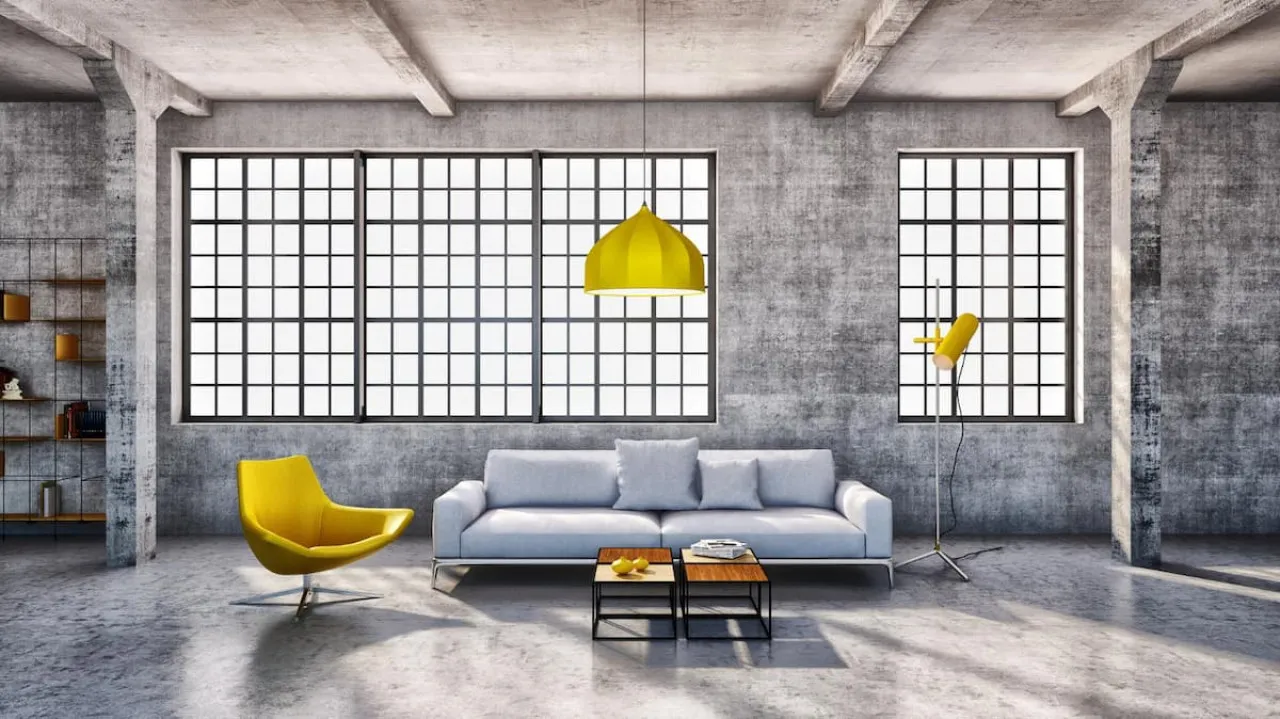Concrete walls are a type of wall commonly used in the construction of multi-story buildings and modern residences, particularly in minimalist, tropical contemporary, and industrial home designs.
Although concrete walls do not yet dominate buildings in Indonesia, the trend of their use is increasing along with the development of modern architectural designs.
Concrete walls are seen as having an appeal that other types of walls, such as red brick, wood, or brick, do not have. However, do you know how to build a concrete wall correctly, as well as the advantages and disadvantages of this type of wall?
If you are still unfamiliar, check out the explanation of concrete wall structure, how to build it, and its advantages and disadvantages below so that you can take the right steps when using it!
How to Build a Concrete Wall
The process of building a concrete wall is relatively more complex than other types of walls. However, if the construction stages are done carefully, the results can be very beneficial due to the well-known sturdy and durable character of concrete.
If you are planning to use concrete walls in your building construction, here is an explanation of how to build a concrete wall:
1. Building the Foundation
- First, excavate a few centimeters of soil to fill with hard castings that will later become the placement area for the concrete blocks. The foundation you make should be 2 times the width of the concrete block.
- Then, install support boards on the perimeter (outside) of the hole so that the castings that will be filled in do not overflow.
- Next, pour the castings into the finished foundation hole until it reaches the edge of the hole. Make sure to pour enough castings and almost fill the hole. If the amount is enough, flatten the castings until the height aligns with the top of the board.
- Wait for the foundation to dry for about 3 days. Remember, do not install concrete blocks on top of the undried castings, as this can cause the structure to collapse and become unstable.
2. Laying Concrete Blocks with Mortar
- Make marks at the corners of the foundation using wooden sticks connected with a string. This step aims to mark the corners and outer edges of the wall to be built.
- Make a mixture of mortar and water by referring to the guidelines on the cement package. Stir the mixture until it has a paste-like texture. During this stage, you should use protective equipment, such as safety glasses, gloves, and a mask.
- Next, spread the mortar in one corner of the foundation using a mortar stick. On the part occupied by the stick, spread the mortar with a thickness of about 3 cm and a width of 20 cm. Continue this step until you reach 3 to 4 concrete blocks.
- Place the angled concrete block on the foundation and adjust its position until it is flat. This is where the rope connected to the stick comes into play, which is to help keep the concrete block installation straight.
- Continue laying the concrete blocks in a straight line formed by the rope, starting from the corner or edge of the wall. Apply mortar with a thickness of 3 cm next to each concrete block. Continue this step until you reach the corner opposite the starting point.
- Before stacking the concrete blocks, check the straightness of the first layer using a water pass. If you want to adjust the straightness of the wall, simply tap the concrete blocks while the mortar is still wet. You should not move the concrete blocks when the mortar has set, as this can make the wall unstable.
- Apply 3 cm-thick mortar on top of the concrete block layer. Next, flatten the mortar until it covers the next 3 blocks that are still in line with the first concrete block. Try not to let the mortar get into the holes of the blocks so that it is not wasted.
- Continue stacking the concrete blocks by positioning the edges parallel to the centerline of the concrete block below. After every 2 to 3 layers, measure the straightness of the wall using a water pass.
- If you are building a tall house or building, you will need to reinforce with ¼-inch concrete iron inserted into each hole of the concrete block.
- When the mortar has hardened slightly, scrape the connection part using a concave scraper to remove any remaining mortar. Start at the horizontal connection, then proceed to the vertical connection.
- Wait for the mortar to harden for at least 24 hours before installing anything on the wall. Although mortar generally dries within 20–40 minutes, waiting at least 24 hours will allow the mortar to hold up better to other construction materials.
Advantages of Concrete Wall
Concrete walls are widely used in various types of building construction because of a number of advantages, both structural and aesthetic. Some of the advantages of concrete walls include:
1. Good Durability
Concrete wall structures have good durability even in extreme weather, for example, when there is heavy rain accompanied by strong winds. In addition, houses with concrete walls also tend to be fireproof.
2. Supporting Energy-Saving Concepts
Fun fact, a house with concrete walls generally feels cooler when the weather outside is hot. Otherwise, when the weather outside is cold, the temperature inside the building can feel warmer. This advantage can be felt if the house has good air circulation.
Read also: 7 Inspiring House Designs with Good Air Circulation
3. Suitable for Minimalist Home Design
In general, minimalist house design will reduce excessive decorative elements. Even without excessive decoration, concrete walls already display a simple, neat, and clean impression. Interested in trying it?
4. No Weathering
The surface of concrete walls will not experience weathering as experienced by wooden walls. In addition, concrete walls also have an advantage over general cement walls, because even though they are often exposed to rainwater, the surface of concrete walls is not easily blackened.
5. Able to Withstand Load Optimally
Houses with concrete walls can withstand heavy loads. The condition is that the construction process must be done properly. If you want to utilize the rooftop area as a garden or a place to relax, concrete walls can be the right choice.
Disadvantages of Concrete Walls
After listening to the explanation above, you might start considering applying concrete walls to your construction project. However, before that, you still need to understand some of the disadvantages of concrete wall structures, such as:
1. Prone to Cracking When Exposed to Shocks & Temperature Influences
Although concrete has strong properties, this material may not be suitable as a material for houses in earthquake-resistant locations. This is because houses with concrete materials are less flexible.
Not only that, but if concrete material falls on humans, it can cause severe injuries or other hazards. So, the using concrete walls must pay attention to these important things.
Read also: Identifying the Cause of Wall Cracks and How to Fix
2. Need to Consider Earthquake Risk
Did you know? Although concrete has a high compressive strength, it has a low tensile strength. Therefore, concrete wall structures will easily crack when experiencing shocks. However, this can be overcome by installing mesh reinforcement.
3. Requires a Relatively High Cost
Working on construction projects with concrete as the main material cannot be done by everyone because it requires specific expertise. This will certainly make the wage budget higher.
In addition to worker wages, some of the things that make the construction of concrete walls require a lot of operational costs include the cost of materials and high market competition.
Concrete vs Red Brick, Which is Better?
To find out how concrete walls and red bricks compare, several criteria can be used as a reference, including the following:
1. Working Time
Working on a concrete wall structure takes a relatively short time. The reason is, concrete panels are generally already produced in factories, so workers can simply install them on building structures.
Unlike the red brick wall, the process is done by compiling one by one. Thus, of course, it takes a lot of time. So, in terms of processing time, concrete walls are superior to brick walls.
2. Sturdiness and Durability
Red brick walls are known to be durable as they are made of clay that is fired at high temperatures, resulting in a dense and hard structure. In addition, these walls also have a long service life. Many buildings with red brick walls can last for hundreds of years.
However, if you are planning to build a multi-storey building or a building that can withstand extra-heavy loads, then concrete walls can be a better solution. The reason is that concrete wall structures are known to be pressure-resistant, waterproof, and extremely weather-resistant.
3. Operating Costs
The budget for red brick wall construction is more economical, especially for non-structural 1–2 storey buildings. Moreover, the need for workers is also relatively easy because it does not require specific skills.
On the other hand, concrete wall construction requires a higher cost. However, this is proportional to the strength obtained, especially if the project to be carried out is a multi-storey building with special structural needs.
So, if you want to save your budget at the beginning, red brick walls can be a solution. However, if you prioritize long-term strength, then concrete walls could be more suitable.
4. Maintenance
As mentioned earlier, concrete walls have strong durability and are resistant to water seepage. This makes the concrete treatment tend to be minimal.
In contrast to red brick walls are more easily cracked and tend to absorb water, so the intensity of maintenance must be more frequent.
Read also: 9 Captivating Classic Red Brick House Design Inspirations
This is an explanation of the details of concrete walls and their comparison with red brick walls. When viewed from various aspects, both have their advantages and disadvantages.
Just adjust it to your preferences and construction project needs. Because in the end, safety and comfort are the most important factors.
One of the determinants of safety is the quality of the material, while one of the determinants of comfort is the ease of manufacture. If you're looking for quality building materials that make the construction process easier, just trust the Ready Mix Concrete and Precast Concrete products from Semen Merah Putih.
Not only that, you can also build optimally resistant concrete walls using Semen Merah Putih Watershield, which has Water Repellent Technology with triple protection for buildings.
Seepage protection from 3 sources (outside, inside, and from the ground) makes buildings stronger, more durable, and less maintenance. Semen Merah Putih Watershield is suitable for all building applications, such as foundations, concrete blocks, castings, brick masonry, plastering, and skim coat.
If the manufacturing process is done correctly, the advantages of the material are maximized, and if you use quality cement such as Semen Merah Putih, the attractiveness and functionality of the concrete wall in your building will be optimal.
Do you want to get complete information about Semen Merah Putih products? Or want to consult to determine the product that suits your project? Contact us immediately and get the best construction solution!



